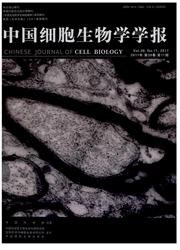

 中文摘要:
中文摘要:
卡哈尔体(Cajalbody,CB)的发现可以溯源至100多年前,而直到近10年的研究取得突破性进展,才逐渐揭示了其复杂的分子组成及生理功能。作为当前备受关注的核内小体之一,CB是细胞核质中处于动态变化的细胞器,广泛存在于高等真核生物的细胞核内,在电镜下表现为球形小体样结构,其中p80Coilin蛋白是CB最为明确的特异性标志物。cB的分子构成十分复杂,主要包括参与mRNA剪接所需、称为snRNP的核酸与蛋白质复合体的各种组分,以及snoRNAs、scaRNAs和其他相关蛋白质。此外,一些基因活化中不可或缺的转录因子、mRNA修饰的必需蛋白因子以及与细胞增殖和细胞周期功能相关的功能分子等,也被发现存在于CB之中或周边。其中,snRNAs、snoRNAs与scaRNAs等低分子量RNAs在CB中完成自身的成熟并且参与RNP的组装。染色体端粒长度的维持以及组蛋白基因簇的表观遗传修饰依赖于cB的形成与功能发挥。由此可见,CB与细胞周期、细胞增殖、应激和老化等一系列重要的细胞生物学过程存在密切的联系,同时其功能和表现的异常往往也提示与肿瘤的发生相关。该文在归纳cB相关研究最新进展的同时,着重讨论CB的结构与功能及其与疾病的潜在联系。
 英文摘要:
英文摘要:
Cajal body (CB) has been discovered more than a century. Nonetheless, it was only lately identi- fled for its complex molecular components and sophisticated functions with the research breakthroughs of the past decade. As an interesting and dynamic organelle in the nucleoplasm, CB widely exist in a vast spectrum of higher eukaryotes and is characterized as the globular structures under the electro-microscope, in which the protein of pS0 Coilin is a distinguishable molecular maker. Various components have been identified in CB, including the nucleic acids and snRNP complex needed for mRNA splicing, snoRNAs and scaRNAs with their associated proteins, cer- tain transcription factors required for gene activation, protein factors for mRNA modification, as well as the key molecules to regulate cell proliferation and cell cycle. CB is known as the exact site for snRNAs, snoRNAs, and scaRNAs maturation, and it is also responsible for maintaining the length of telomeres. Hence, CB is believed to re-late closely with cell cycle and the proliferation, stress and aging of cells. The abnormal function of CB is suggested to associate with disease processes, such as tumorigenesis. This review summarizes the latest advances of CB-relat- ed research, and discusses mainly about the structure and function of the Cajal body in connection with diseases.
 同期刊论文项目
同期刊论文项目
 同项目期刊论文
同项目期刊论文
 期刊信息
期刊信息
